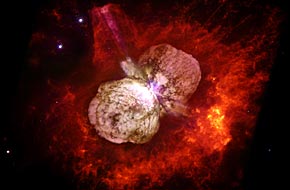Oh, how I wish the Hubble Space Telescope had been around in the 1840s. That's when a star in the southern constellation of Carina brightened dramatically and for a time became the second-brightest star in the nighttime sky.

The Hubble Space Telescope captures the glory of the about-to-go-supernova Eta Carinae. When it blows, it may be as big as the largest stellar explosion seen so far.
Nathan Smith / Jon Morse / NASA
In the decades afterward, astronomers noticed an expanding shell of matter surrounding the perplexing star. The double-lobed glow, now known as the Homunculus Nebula, wasn't growing fast enough to be debris from a supernova blast. And the star itself, Eta Carinae, survived. It slowly faded to 8th magnitude, only to flare again in the late 1990s.
Astronomers have long regarded Eta Carinae as a supernova impostor, believing that in 1843 this stellar behemoth somehow burped a dozen Suns' worth of gas and dust into space and then settled down. Outweighing our Sun by 90 to 100 times, it probably had half again that mass when it formed a few million years ago.
Until now, the most common explanation has been that the star's intense radiation blew matter off its surface at prodigious rates. Such an effusive solar wind wouldn't be extremely fast, not even close to the velocity of a supernova's blast, which seemed to match the expansion rate of the nebula nicely.
But new research suggests that this megastar might have had more going on. In September 11th's Nature, Nathan Smith (University of California, Berkeley) reports finding faint filaments near the star racing outward at a few thousand miles (3,500 to 6,000 km) per second — much faster than anything observed in the Humunculus Nebula to date.
He tracked the nebula's outflow two ways. A spectrometer attached to the Gemini South 8-meter telescope high in the Chilean Andes recorded the movement of helium atoms, which have a strong infrared emission at 1.08 microns. Then, hopping over to the Blanco 4-meter telescope at nearby Cerro Tololo, he clocked velocities using Doppler shifts at deep-red wavelengths emitted by nitrogen-rich gas.
To Smith, the evidence suggests that Eta Carinae's 1843 eruption resulted from a violent disturbance within the star. "Rather than a steady wind blowing off the outer layers," Smith comments in a press release, "it seems to have been an explosion that started deep inside the star and blasted off its outer layers."
Smith believes a new kind of disruption must be involved that causes the innards of such massive stars to become highly unstable without blowing themselves to smithereens.
However, not everyone thinks Eta Carinae is the source of the observed outburst. This star has a smaller, hotter companion in a looping orbit that periodically brings the two within 1 or 2 astronomical units of one another, and some astronomers think it could be stirring up trouble instead.
"There is strong disagreement about the nature of Eta Carinae," comments Theodore Gull (NASA/Goddard Space Flight Center). "There is no reason that the secondary could not have thrown out that much material and more."
Smith doesn't find that plausible. "The companion star has a very close passage every 5½ years, but Eta Carinae doesn't have a huge eruption every 5½ years," he counters. "Instead, something wild happened to the primary star in 1843."
 1
1
Comments
A. A. Szautner
September 12, 2008 at 10:27 pm
If the 1843 eruption was carbon-burning equivalent to the "helium flash" seen in other progenitors, the supernova of Eta Carinae could be imminent.
Models for progenitors of a mere 25 solar masses show that once carbon burning commences in the core (which expands into a carbon-burning shell to produce neon), it's only a matter of about 280 years or so before the core begins to run through the rest of the process very rapidly indeed, successively burning neon (a little over a year), oxygen (about 5 months) silicon (only a little over a day) to produce the unburnable isotope 56nickel (or "iron") core, which spells doom as soon as it becomes critically massive...
But since Eta Carinae is thought to be over three times as massive as that theoretical model, and if that event signaled the onset of carbon-burning, the carbon burning stage may already be nearing it's end at this very moment, only 165 years after the 1843 outburst. Hope astronomers are making sure they monitor it continuously - "light-news" of the supernova may be on its way and could arrive at any moment.
You must be logged in to post a comment.
You must be logged in to post a comment.